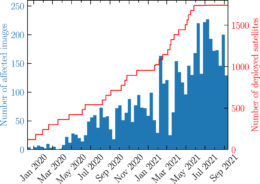Editor’s Note: In these last two weeks of 2022, we’ll be looking at a few selections that we haven’t yet discussed on AAS Nova from among the most-downloaded articles published in AAS journals this year. The usual posting schedule will resume in January.
Impact of the SpaceX Starlink Satellites on the Zwicky Transient Facility Survey Observations

Number of Zwicky Transient Facility images containing Starlink satellite tracks (blue bars) and the cumulative number of satellites (red line) as a function of time. [Mróz et al. 2022]
Published January 2022
Main takeaway:
Przemek Mróz (University of Warsaw, Poland) and collaborators counted how many images from the Zwicky Transient Facility, which operates a telescope that scans the entire northern sky every two days, contain streaks from Starlink satellites passing through the field of view. The percentage of satellite-streaked images increased by a factor of nearly 36 in less than two years, highlighting the growing presence of satellite constellations and their potential impact on ground-based astronomy.
Why it’s interesting:
The number of Earth-orbiting satellites has increased dramatically in the past few decades and is expected to continue increasing. Though each satellite track obscures a small fraction of a telescope’s field of view — Mróz’s team calculated that a single track covers just 0.04% of the Zwicky Transient Facility’s detector — the chances of a passing satellite marring an astronomical image will increase as the number of satellites skyrockets.
Prospects for future satellites, and what this means for observations going forward:
Much of the recent growth in the satellite population has been driven by the addition of thousands of SpaceX Starlink satellites, which aim to provide internet access for remote or rural areas; as of this writing, there are more than 3,300 Starlink satellites in orbit. This is a small fraction of the nearly 20,000 Starlink satellites that have already been approved, with further additions to the Starlink family already planned. Mróz and collaborators found that Starlink satellites have yet to dramatically affect observations by the Zwicky Transient Facility, partially due to image processing techniques that remove the satellite trails, but other observatories may suffer more negative impacts due to the specifics of their detectors. Though efforts to dull the shine of Starlink satellites have dimmed the satellites by a factor of 4.6, they are still brighter than was recommended in the first Satellite Constellations workshop report.
Citation
Przemek Mróz et al 2022 ApJL 924 L30. doi:10.3847/2041-8213/ac470a

